Wondering about the Best Things to Do in Kampala? Read on. Uganda is blessed with amazing tourist attractions. Talk of national parks like Queen Elizabeth, Murchison Falls, Kidepo and Bwindi Impenetrable forest. Tourists can take part in amazing activities like gorilla trekking, mountain hiking, whitewater rafting in Jinja, visiting lake Bunyonyi and the Ssese Islands in lake Victoria to mention but a few. Because most of these exciting activities and attractions are found in the countryside, a tour of the capital Kampala is not a priority for most tourists. This should not be the case when you consider all that the city has to offer.
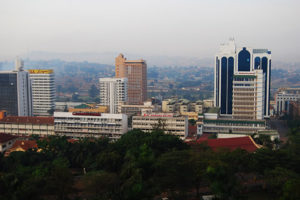 Kampala is by far the largest urban center in Uganda and sits on 7 major hills (Old Kampala, Makerere, Kibuli, Rubaga, Mengo, Kololo and Mulago). Before the British Colonial government turned it into a major administrative center, the area now know as Kampala was covered by vast grasslands and wetlands which attracted large herds of antelopes. The area became a favorite hunting ground for the Kabaka of Buganda (Mutesa 1). The colonial administrators named the area Kampala because of the large number of Impala roaming the area.
Kampala is by far the largest urban center in Uganda and sits on 7 major hills (Old Kampala, Makerere, Kibuli, Rubaga, Mengo, Kololo and Mulago). Before the British Colonial government turned it into a major administrative center, the area now know as Kampala was covered by vast grasslands and wetlands which attracted large herds of antelopes. The area became a favorite hunting ground for the Kabaka of Buganda (Mutesa 1). The colonial administrators named the area Kampala because of the large number of Impala roaming the area.
There is so much to see in this fast growing and busy city of about 1.5 million people. This article centers on the best things and attractions within and around the city as it is today. It is recommended that you set aside a whole day in order to see the best that the city of Kampala has to offer. You can learn more from our 1 day Kampala tour package or how to arrange a road trip in Uganda. The best and most efficient means of transport (though risky) around the city is by using boda bodas (motorcycle). These bikes are very efficient in traversing through heavy traffic and are very affordable.
Here is the complete list of attractions and things to do in Kampala. Before we go to the list, you might want to check out the top activities in Entebbe town or tourist attractions in Mbarara. You might also want to hire a car in Kampala, visit Jinja in one day or check out an article about the cultural sites in Uganda as a whole.
Things to do in Kampala City
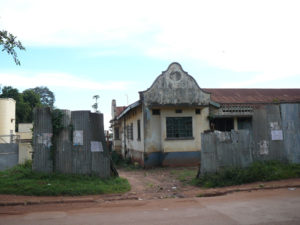 Old Kampala: Old Kampala sits on the original Kampala Hill. It is where the first administrative blocks were built before the city expanded and most administrative buildings were shifted to a more central location. Old Kampala stands out because of the unique old colonial and Indian style buildings. A lot has changed a recently with the building of more modern shopping malls but the old building still remain. Old Kampala offers the best opportunity to see how Kampala looked like.
Old Kampala: Old Kampala sits on the original Kampala Hill. It is where the first administrative blocks were built before the city expanded and most administrative buildings were shifted to a more central location. Old Kampala stands out because of the unique old colonial and Indian style buildings. A lot has changed a recently with the building of more modern shopping malls but the old building still remain. Old Kampala offers the best opportunity to see how Kampala looked like.
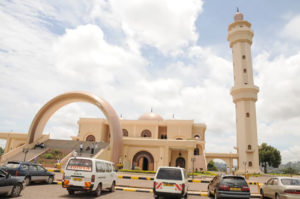 The Gaddafi Mosque: This is the largest mosque in Uganda with the capacity to accommodate over 15,000 worshipers. Idi Amin Dada started building the mosque in 1972 but it was completed in 2007 with a generous donation from Colonel Muammar Gadaffi of Libya. The Gaddafi mosque is built on top of one of the 7 major hills of Kampala and at the spot where the colonial capital was located.
The Gaddafi Mosque: This is the largest mosque in Uganda with the capacity to accommodate over 15,000 worshipers. Idi Amin Dada started building the mosque in 1972 but it was completed in 2007 with a generous donation from Colonel Muammar Gadaffi of Libya. The Gaddafi mosque is built on top of one of the 7 major hills of Kampala and at the spot where the colonial capital was located.
Climbing to the highest point of this mosque rewards tourists with one of the best views of Kampala city. The administrators of the mosque have been considerate enough to allow tourists visit the mosque and take photos at a small fee of about $3. Women are required to cover themselves with a headscarf (available at the offices) before entering the mosque. You can plan your visit to the Gadaffi Mosque with one of the leading tour companies in Uganda. Visitors are led around the premises by an in-house Tour Guide.
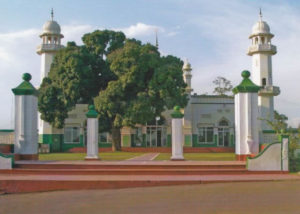 Kibuli mosque: This is the most popular mosque in Uganda and is where the top Sheiks reside. Because of that, the mosque is regarded as the center of all Muslim activities in Uganda. The mosque lies on one of Kampala’s original 7 hills (Kibuli) offering great views of the capital city. Prince Badru Kakungulu of Buganda donated the land where the mosque stands to the Muslim fraternity in Uganda.
Kibuli mosque: This is the most popular mosque in Uganda and is where the top Sheiks reside. Because of that, the mosque is regarded as the center of all Muslim activities in Uganda. The mosque lies on one of Kampala’s original 7 hills (Kibuli) offering great views of the capital city. Prince Badru Kakungulu of Buganda donated the land where the mosque stands to the Muslim fraternity in Uganda.
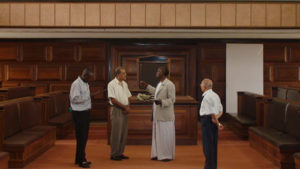 The Buganda Parliament (Bulange): The Buganda parliament holds sessions every month where several issues pertinent to the Kingdom are discussed. The Kabaka (King) of Buganda only attends the opening and closing sessions. Before Uganda was colonized, these sessions were held under a large tree or grass-thatched buildings. The Buganda parliament building received a major facelift with more modern ones around the time of independence. A guided tour around this building will provide fascinating insights about the history of the Buganda Kingdom, the fifty six clans and former kings.
The Buganda Parliament (Bulange): The Buganda parliament holds sessions every month where several issues pertinent to the Kingdom are discussed. The Kabaka (King) of Buganda only attends the opening and closing sessions. Before Uganda was colonized, these sessions were held under a large tree or grass-thatched buildings. The Buganda parliament building received a major facelift with more modern ones around the time of independence. A guided tour around this building will provide fascinating insights about the history of the Buganda Kingdom, the fifty six clans and former kings.
Kabaka’s Palaces in Mengo and Lubiri: The Mengo palace building is built on top of one of Kampala’s major hills (Mengo) and close to the Buganda parliament (Bulange). The palace has largely been abandoned since Kabaka Mutesa II was ousted by President Milton Obote in 1996. After the King was ousted by president Milton Obote, his replacement Idi Amin Dada turned a section of it into a notorious torture chamber. Over 250 people are believed to have been killed at different points during president Idi Amin’s rule. Amin was ruthless to anyone he saw as a threat to his rule.
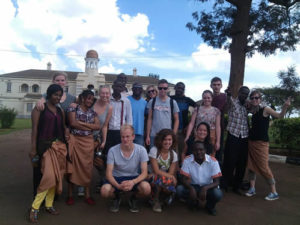 Most of the building is closed to visitors but one can request for a guided tour of the torture chamber within the palace at a fee of $3. While at the Chambers, you will listen to sad stories of the people killed including top businessman, politicians, soldiers and basically anyone who seemed a threat to the dictator. The walls at the cambers still bare blood and human waste as a reminder of the terrible ordeal the inmates faced. The Kabaka currently stays in the Lubiri palace. Lubiru is the official palace but the Kabaka has other palaces in Banda next to Kyambogo University. Check out our article about the things to do in Dar es Salaam.
Most of the building is closed to visitors but one can request for a guided tour of the torture chamber within the palace at a fee of $3. While at the Chambers, you will listen to sad stories of the people killed including top businessman, politicians, soldiers and basically anyone who seemed a threat to the dictator. The walls at the cambers still bare blood and human waste as a reminder of the terrible ordeal the inmates faced. The Kabaka currently stays in the Lubiri palace. Lubiru is the official palace but the Kabaka has other palaces in Banda next to Kyambogo University. Check out our article about the things to do in Dar es Salaam.
The Kabaka’s lake: This Lake is 200 ft deep and is the largest man-made/excavated lake in Africa. The Kabaka’s Lake is found in Ndeeba and was built by Kabaka Mwanga of Buganda. The King wanted to connect the palace to Lake Victoria while also providing an escape route in case of a major war or revolt by his subjects. The Kabaka took part in the digging process to encourage his subjects. To this day, clan leaders of Buganda consider the lake sacred and occasionally gather to clean it. This beautiful lake is now a tourist attraction on its own and offers a perfect atmosphere for relaxation, boat rides/racing and bird watching. There are several accommodation facilities around the lake for those who wish to spend more time there.
Kasubi Tombs: This one of the several UNESCO World Heritage Sites in Uganda. This large grass-thatched building is a very important site to the Baganda people. It is also among the leading tourism sites in Uganda. The Kasubi Tombs are burial ground for 4 of Buganda’s former kings. While at the tombs, tourists can spot the large hut holding the tombs, the royal clothing, hunting tools and other monuments of these past kings. The Baganda believe that their kings do not die but simply disappear to another world. The Royal guides will narrate stories about each of the kings and the roles they played during their reign. The Kasubi Tombs are taken care of by descendants of the Kings wives.
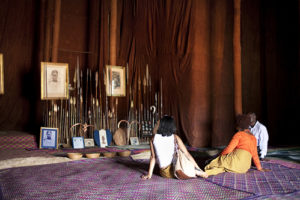 After visiting the Kasubi tombs, you can also visit the lesser known Wamala Tombs. These tombs were built 11 kilometers away from those at Kasubi and along Hoima Road. Kabaka Suuna II is buried here. He was a very powerful King but feared for being strict. Upon his death, he was replaced by a more likeable leader Kabaka Mutesa I. The Nnamasole Kanyange tombs are also worth visiting and are close to the Wamala tombs. You might also want to visit the Katereke Prison Ditch were one of the Buganda kings (Kabaka Kalema) killed thirty of his brothers to retain control of the throne. You might be interested in the tourist attractions in Nairobi.
After visiting the Kasubi tombs, you can also visit the lesser known Wamala Tombs. These tombs were built 11 kilometers away from those at Kasubi and along Hoima Road. Kabaka Suuna II is buried here. He was a very powerful King but feared for being strict. Upon his death, he was replaced by a more likeable leader Kabaka Mutesa I. The Nnamasole Kanyange tombs are also worth visiting and are close to the Wamala tombs. You might also want to visit the Katereke Prison Ditch were one of the Buganda kings (Kabaka Kalema) killed thirty of his brothers to retain control of the throne. You might be interested in the tourist attractions in Nairobi.
The Baha’i Temple: The Bahai Temple in Kampala is built on Kikaya hill near Gayaza road. The temple is special because it is the only one of the Baha’i faith in Africa. It is a magnificent building sitting on a large piece of land which offers a serene environment for relaxation and bird watching. The temple grounds are also a favorite place for meditation and are frequented by people from all religious backgrounds. From its raised position, the Baha’i Temple provides great views of Kampala city and the surrounding suburbs. If you are interested in knowing more about the Baha’i faith, you should attend their Sunday service.
Uganda Martyrs Shrines in Namugongo: The Uganda Martyrs Shrine Namugongo is located close to the Kampala-Jinja highway and is one of the most visited religious sites in Africa. In June 1886, about 32 Christians were burnt alive or simply speared to death on the orders of Kabaka Mwanga. Their crime was refusing to denounce Christianity and the Muslim faith. 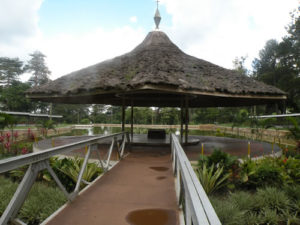 After accepting them in the beginning, the Kabaka grew to hate all foreign religions, seeing them as a threat to his rule.
After accepting them in the beginning, the Kabaka grew to hate all foreign religions, seeing them as a threat to his rule.
The Kabaka was particularly angry that the some of his pages were no longer obeying some of his orders after their conversions. The Shrines were built to remember the young and brave converts who refused to denounce their faith even after undergoing great suffering. Over one million people congregate at Namugongo every 3rd of June to celebrate the Uganda Martyrs day. The Shrines in Namugongo offer opportunities to learn something about the history of Christianity in Uganda. The Roman Catholic shrine in particular has a beautiful environment for relaxation, meditation and prayer.
Namirembe Cathedral: This is arguably the most beautiful cathedral of the Anglican faith in Uganda. It is also known as St. Paul’s Cathedral and was built in 1919 making it the oldest in Uganda. Namirembe Cathedral sits on a spot with great views of Kampala city. The Archbishop of the Church of Uganda (Anglican Church) resides in a building next to the cathedral. 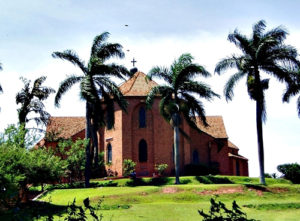 If you are a member of the Anglican Church and are looking for a good spot for worshiping, then this might just be the place to go to. The cathedral also has a graveyard with remains of Ernest Cook and Bishop Hannington (murdered in 1885 on orders of Kabaka Mwanga). Ernst Cook was the nephew of Sir Albert Cook (a colonial administrator) and is credited for having built the large Mengo hospital. While visiting the cathedral, don’t miss to check out a small hut housing the large drums used to call worshipers for service. You can complete your tour of the cathedral by having tasty lunch at the Namirembe guest house.
If you are a member of the Anglican Church and are looking for a good spot for worshiping, then this might just be the place to go to. The cathedral also has a graveyard with remains of Ernest Cook and Bishop Hannington (murdered in 1885 on orders of Kabaka Mwanga). Ernst Cook was the nephew of Sir Albert Cook (a colonial administrator) and is credited for having built the large Mengo hospital. While visiting the cathedral, don’t miss to check out a small hut housing the large drums used to call worshipers for service. You can complete your tour of the cathedral by having tasty lunch at the Namirembe guest house.
Rubaga Cathedral: Rubaga Cathedral is also built in one of Uganda’s major hills with good views of the capital. It is where the headquarters of the Roman Catholic faith in Uganda is located. Before the Cathedral was built in 1914, one of the palaces of Kabaka Mutesa I sat on the land. 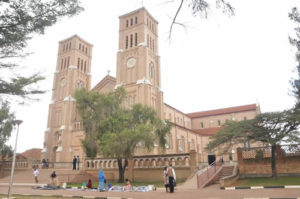 His son Kabaka Mwanga II later donated the land to the French Catholic missionaries. The construction of the current church started in 1914 and ended in 1925. Ironically, the cathedral was built in memory of the 22 catholic martyrs of Uganda burnt in Namugongo under the orders of the same Kabaka who gave out the church land. While on a visit to the church, do not forget to visit the burial ground of the first African catholic bishop and later Archbishop Joseph Kiwanuka. Entering the church is free but donations can be made at the church offices.
His son Kabaka Mwanga II later donated the land to the French Catholic missionaries. The construction of the current church started in 1914 and ended in 1925. Ironically, the cathedral was built in memory of the 22 catholic martyrs of Uganda burnt in Namugongo under the orders of the same Kabaka who gave out the church land. While on a visit to the church, do not forget to visit the burial ground of the first African catholic bishop and later Archbishop Joseph Kiwanuka. Entering the church is free but donations can be made at the church offices.
Jewish Synagogue and community Uganda: The Jewish community in Uganda have a Synagogue in Kibuli (along Mbogo Road). This community of believers share a common love for Hashem and respecting the Torah. They gather for fellowship several times a week and spend time visiting the local community or prison inmates. The Jewish community has initiated many development projects to support the public in education and health. The Galilee Community General Jewish hospital for example helps cover gaps in medical services. The Jewish Synagogue also organizes teachings and books in Jewish for learners while encouraging the recitation of the Shema twice a day. Visit this community if you believe in the Jewish faith or wish to learn more.
Gurdwara Ramgarhia Sabha: This is where the Gurdwara Indians go for fellowship and worshiping. The temple is led by a group of Sikhs who spend their day reciting, listening to devotional hymns and having communal meals. The Gurdwara Indians have built several temples in Africa and attracted the attention of masses interested in their unique style of worship.
Owino Market: Owino Market was recently renamed St. Balikuddembe market but the locals still prefer the old name. The market is located near the main Kampala taxi park. It is the busiest market in Kampala and attracts thousands of shoppers every day. 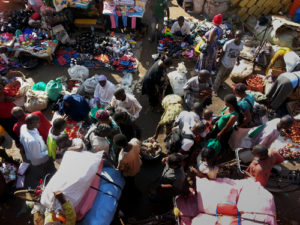 Owino is a chaotic market but one can find almost anything from clothes, shoes, fresh fruits, food and traditional medicine. The second-hand designs in Owino Market are in great condition and come from the best designers around the world. You can also buy your own fabrics and have it put together by expert local tailors. Owino market will give you a different perception of the city of Kampala – especially if you are coming from the more glamorous residents in Muyenge or Kololo. Be ready to haggle to get the best price and lookout for goons who are always looking for a good opportunity to snatch your bag or jewelry. Better to move in a group or with a trusted local guide to avoid being bullied into buying something you don’t want or at inflated prices.
Owino is a chaotic market but one can find almost anything from clothes, shoes, fresh fruits, food and traditional medicine. The second-hand designs in Owino Market are in great condition and come from the best designers around the world. You can also buy your own fabrics and have it put together by expert local tailors. Owino market will give you a different perception of the city of Kampala – especially if you are coming from the more glamorous residents in Muyenge or Kololo. Be ready to haggle to get the best price and lookout for goons who are always looking for a good opportunity to snatch your bag or jewelry. Better to move in a group or with a trusted local guide to avoid being bullied into buying something you don’t want or at inflated prices.
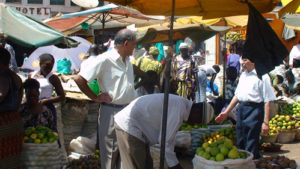 Apart from Owino Market, there is also the Nakasero or Wandegeya market. Nakasero market is found within the city center and is the best place to shop for fresh food, grains and electronics. It has all types of vegetables and fresh fruits. The market is surrounded by large storied buildings which house the best hardware and electronics shops.
Apart from Owino Market, there is also the Nakasero or Wandegeya market. Nakasero market is found within the city center and is the best place to shop for fresh food, grains and electronics. It has all types of vegetables and fresh fruits. The market is surrounded by large storied buildings which house the best hardware and electronics shops.
Wandegeya Market on the other hand is located close to Makerere University. It is a favorite shopping place for University students and other city dwellers staying in the suburbs of Kamokya, Ntinda, Bugolobi and Kololo. Wandegeya Market is were the best Rolex (omelets and grain) are made. The market also has offices, boutiques, restaurants and some of the best joints for roasted chicken, pork and goats meat. Visiting these markets will enable you to understand the Ugandan culture. You need to be good at bargaining to avoid being over-charged especially if you look a foreigner.
Buy A book or visit a library: Aristoc Booklex is the most popular bookstore for buying novels and Ugandan books (in English). They have grown to have two branches in Garden city and the Acacia Mall.
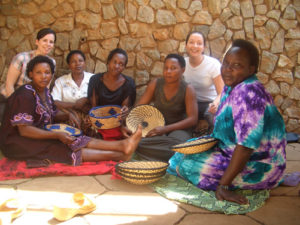 Craft Markets, Art Galleries and Monuments: There are several permanent and temporary shops/markets selling locally made jewelry, sculptures, paintings, fabrics and art pieces. You can visit the large crafts shop at the national theater or go to Gerald’s Antiques for old stamps and Ugandan bank notes. Exposure Africa has beautiful jewelry and wood carvings while Uganda Crafts 2000 Ltd has great paintings and traditional bitenge in all colors. If you need more Kitenge designs then visit the Kampala Fair, Bold for African designs, Banana Boat and Quality Hill (They also have eye-catching Congolese designs).
Craft Markets, Art Galleries and Monuments: There are several permanent and temporary shops/markets selling locally made jewelry, sculptures, paintings, fabrics and art pieces. You can visit the large crafts shop at the national theater or go to Gerald’s Antiques for old stamps and Ugandan bank notes. Exposure Africa has beautiful jewelry and wood carvings while Uganda Crafts 2000 Ltd has great paintings and traditional bitenge in all colors. If you need more Kitenge designs then visit the Kampala Fair, Bold for African designs, Banana Boat and Quality Hill (They also have eye-catching Congolese designs).
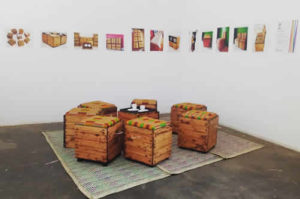 For the best art galleries, visit 32° East Ugandan Arts Trust, the Asante Art Gallery and Afriart Gallery. These galleries bring together some of the best Ugandan artists to showcase their products. You might also want to check out the Makerere Art Gallery for their monthly art exhibitions and large sculptures. Other art galleries and centers worth visiting for local souvenirs are the Uganda Art Gallery near Namirembe Cathedral, Karibu Art Gallery, Umoja Art Gallery, Craft African for Kenyan/Ugandan art, AKA Gallery/Geoffrey Mukasa collection and the Nommo Gallery for quality art pieces.
For the best art galleries, visit 32° East Ugandan Arts Trust, the Asante Art Gallery and Afriart Gallery. These galleries bring together some of the best Ugandan artists to showcase their products. You might also want to check out the Makerere Art Gallery for their monthly art exhibitions and large sculptures. Other art galleries and centers worth visiting for local souvenirs are the Uganda Art Gallery near Namirembe Cathedral, Karibu Art Gallery, Umoja Art Gallery, Craft African for Kenyan/Ugandan art, AKA Gallery/Geoffrey Mukasa collection and the Nommo Gallery for quality art pieces.
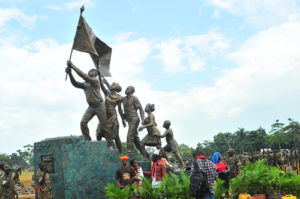 Independence monument: The independence monument was built just before Uganda’s independence in October 1962. It is close to the Sheraton hotel in Kampala. The monument is a structure of a man lifting up a child towards the sky (signifying how the country was let free after colonization). The monument is made of sand, cement, wire mesh and iron bars. Gregory Maloba, a lecturer of Makerere University was responsible for implementing the design. Another independence monument was put up more recently at the Kololo Airstrip to commemorate 50 years of Uganda’s independence.
Independence monument: The independence monument was built just before Uganda’s independence in October 1962. It is close to the Sheraton hotel in Kampala. The monument is a structure of a man lifting up a child towards the sky (signifying how the country was let free after colonization). The monument is made of sand, cement, wire mesh and iron bars. Gregory Maloba, a lecturer of Makerere University was responsible for implementing the design. Another independence monument was put up more recently at the Kololo Airstrip to commemorate 50 years of Uganda’s independence.
Lake Victoria for the beaches and boat cruises: Lake Victoria is one of the two largest freshwater lakes in the world. A boat cruise on the Lake Victoria can take you to some of the best spots in Kampala and Entebbe. Most boat cruises end up in the Ngamba and Ssese Islands. There are a number of companies offering boat cruises around the lake at an affordable fee. 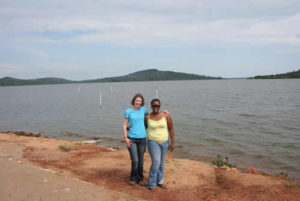 Ensure that you go with a reputable company offering well-maintained boats. Most of the boats stop at different landing sites and islands for sightseeing, refreshment and lunch (fried tilapia and chips). If you aren’t interest in the boat cruises, you can relax and swim in the numerous private/hotel-owned beaches in Ggaba and Munyonyo. The beaches include KK Resort Beach, One love beach, Speke Resort Munyonyo, Gaba Beach Hotel, Mulungi Kabaka’s Recreation Center and Kawuku Water Sports Club. These beaches and facilities offer opportunities to take part in sport fishing, birding, canoeing, horseback riding and much more. You should also read our article about the the best things to do in Mombasa.
Ensure that you go with a reputable company offering well-maintained boats. Most of the boats stop at different landing sites and islands for sightseeing, refreshment and lunch (fried tilapia and chips). If you aren’t interest in the boat cruises, you can relax and swim in the numerous private/hotel-owned beaches in Ggaba and Munyonyo. The beaches include KK Resort Beach, One love beach, Speke Resort Munyonyo, Gaba Beach Hotel, Mulungi Kabaka’s Recreation Center and Kawuku Water Sports Club. These beaches and facilities offer opportunities to take part in sport fishing, birding, canoeing, horseback riding and much more. You should also read our article about the the best things to do in Mombasa.
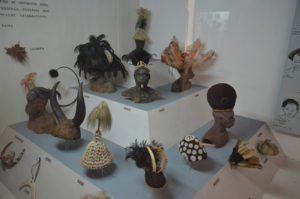 The Uganda National Museum: The Uganda National Museum was founded in 1908 by George Wilson (A British Colonial Governor) making it the oldest and largest museum in Uganda. The museum was built to showcase the cultural heritage and historical milestones in the country including religion, clothing, agriculture and medicine among others. The museum has different sections, each showing the culture and natural resources of the country. Several artifacts like local music instruments and ancient hunting tools (spears, bows, and arrows) are on display for those who can pay an entrance fee of about 7 US Dollars.
The Uganda National Museum: The Uganda National Museum was founded in 1908 by George Wilson (A British Colonial Governor) making it the oldest and largest museum in Uganda. The museum was built to showcase the cultural heritage and historical milestones in the country including religion, clothing, agriculture and medicine among others. The museum has different sections, each showing the culture and natural resources of the country. Several artifacts like local music instruments and ancient hunting tools (spears, bows, and arrows) are on display for those who can pay an entrance fee of about 7 US Dollars.
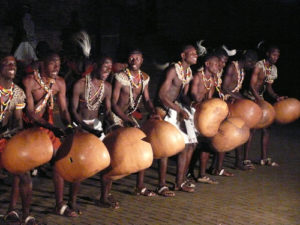 The Ndere Centre: This cultural Center is found outside the city center in an area known as Kisasi. The Centre showcases the cultural heritage of all tribes in Uganda using traditional music, dance and drama among others. The Ndere Centre offers opportunities to learn how to cook local dishes or dance to local tunes. If you are not interested in learning the local dances, you can just sit back and watch beautiful traditional dance performances from the famous Ndere Troupe.
The Ndere Centre: This cultural Center is found outside the city center in an area known as Kisasi. The Centre showcases the cultural heritage of all tribes in Uganda using traditional music, dance and drama among others. The Ndere Centre offers opportunities to learn how to cook local dishes or dance to local tunes. If you are not interested in learning the local dances, you can just sit back and watch beautiful traditional dance performances from the famous Ndere Troupe.
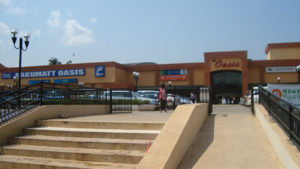 Shopping Malls: Kampala is a city with countless supermarkets and large shopping centers. The Garden City Complex is one of the most popular shopping centers in Kampala. It’s got several supermarkets, shops restaurants, bookshops and jewelry shops. Other large supermarkets include Game and the one found in Freedom city along Entebbe road. Most of these large shopping malls accept international credit cards.
Shopping Malls: Kampala is a city with countless supermarkets and large shopping centers. The Garden City Complex is one of the most popular shopping centers in Kampala. It’s got several supermarkets, shops restaurants, bookshops and jewelry shops. Other large supermarkets include Game and the one found in Freedom city along Entebbe road. Most of these large shopping malls accept international credit cards.
Restaurants and other eat-outs: As the capital city, Kampala brings together tribes and cultures from different parts of the country. Each tribe has its own special dish. Why not visit one of the top town restaurants and taste some of the local dishes available like “matooke” (smashed cooked bananas) or “Kalo” (mingled millet bread). 2K Restaurant serves the best Ugandan dishes like steamed beef and Luwombo.
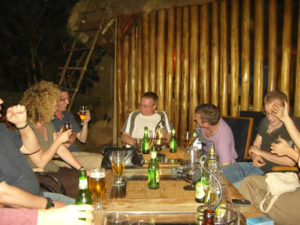 An even more interesting thing to do is visit one of the specialist restaurants like Mediterraneo. Mediterraneo is an Italian restaurant offering tasty Italian pastas and pizzas. Another popular Italian restaurant/bar is Cantine Divino offering expensive wine with good food. For the best Mexican food, visit Little Donkey for their tacos, nachos and burritos. Le Chateau on the other hand serves Belgium food washed down with cold Belgium beer. Khana Khazana, Masala Chaat House, Haandi, Great Indian Dhaba prepare the best Indian food in town. Mama Ashanti prepares the best West African dishes like egusi while Yujo Izakaya specializes in Japanese food (sashimi and sushi). You can also visit Tamarai for the best Thai food or Miso Garden for Korean and Japanese dishes. For those interested in game meat (wildebeest, crocodile and ostrich e.t.c) visit the lawns. Other restaurants worth visiting in town include Bistro for delicious pastas, Fez Brasserie near Emin Pasha hotel for selected vegetarian meals, Prunes for serving Ugandan coffee and food of every kind including goats meat.
An even more interesting thing to do is visit one of the specialist restaurants like Mediterraneo. Mediterraneo is an Italian restaurant offering tasty Italian pastas and pizzas. Another popular Italian restaurant/bar is Cantine Divino offering expensive wine with good food. For the best Mexican food, visit Little Donkey for their tacos, nachos and burritos. Le Chateau on the other hand serves Belgium food washed down with cold Belgium beer. Khana Khazana, Masala Chaat House, Haandi, Great Indian Dhaba prepare the best Indian food in town. Mama Ashanti prepares the best West African dishes like egusi while Yujo Izakaya specializes in Japanese food (sashimi and sushi). You can also visit Tamarai for the best Thai food or Miso Garden for Korean and Japanese dishes. For those interested in game meat (wildebeest, crocodile and ostrich e.t.c) visit the lawns. Other restaurants worth visiting in town include Bistro for delicious pastas, Fez Brasserie near Emin Pasha hotel for selected vegetarian meals, Prunes for serving Ugandan coffee and food of every kind including goats meat.
The more established restaurant brands offer intercontinental meals and include Café Javas, Nandos, New City Annex Hotel, La Fontaine and Casablanca in Kololo.
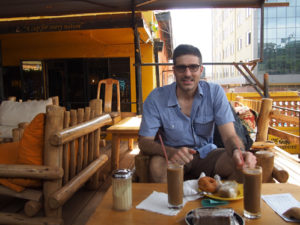 Coffee Shops: For the best Bugisu Arabica coffee and other contemporary brands, you need to visit 1000 Cups Coffee House, Antonios or Endiro. Other great places for great Ugandan coffee include Kardamom & Koffee (for the great environment including a small bookshop) and Café Pap along Parliament Avenue. Java House on the other hand serves strong Kigezi coffee as well as breakfast, fires, sandwiches and salads.
Coffee Shops: For the best Bugisu Arabica coffee and other contemporary brands, you need to visit 1000 Cups Coffee House, Antonios or Endiro. Other great places for great Ugandan coffee include Kardamom & Koffee (for the great environment including a small bookshop) and Café Pap along Parliament Avenue. Java House on the other hand serves strong Kigezi coffee as well as breakfast, fires, sandwiches and salads.
Bars, Nighclubs and other Hangouts: Kampala is a city that never sleeps. If you want to spend your evening partying/ eating, check out Deuces, Bubbles O’Learys or Big Mike’s. They all serve beer and organize local comedy shows that bring together Uganda’s middle class. For the best and most recent 3D blockbusters, look no further than Century Cinemax. 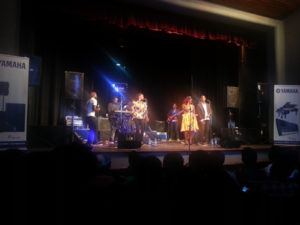 The National Theater organizes comedy nights, drama, dance, live music and movies accompanied by beer, food and soft drinks. The Otters Bar with its beautiful gardens serves beer, snacks and pizza. The Musicians Club brings together Uganda’s local artists for great live performances attended by Kampala’s working class and expatriates. Other popular hangouts include Cayenne for the best live music and DJ’s. Iguana is a favorite hangout for expatriates while the Rock Garden is considered one of the cool places to be for great rock music. The best and oldest mainstream nightclubs are Ange Noir and Club Guvnor along industrial area. Both play the latest international club hits including African music up to the wee hours of the morning.
The National Theater organizes comedy nights, drama, dance, live music and movies accompanied by beer, food and soft drinks. The Otters Bar with its beautiful gardens serves beer, snacks and pizza. The Musicians Club brings together Uganda’s local artists for great live performances attended by Kampala’s working class and expatriates. Other popular hangouts include Cayenne for the best live music and DJ’s. Iguana is a favorite hangout for expatriates while the Rock Garden is considered one of the cool places to be for great rock music. The best and oldest mainstream nightclubs are Ange Noir and Club Guvnor along industrial area. Both play the latest international club hits including African music up to the wee hours of the morning.
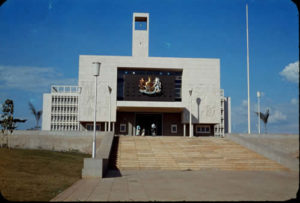 Uganda Parliament Building: The Parliament building is located right at the city center. A tour of the parliament building in Uganda is a good way to learn about Uganda’s current political system. You can witness the parliament in action as the Members of Parliament tackle some of the current issues facing the country while also proposing and preparing bills for approval by the president. Parliamentary sessions are open on Tuesdays and Thursday from 2 to 4pm. You need to book a spot in the visitors sitting area in advance from the PR department. Dress decently and present identification documents to access the heavily guarded premises.
Uganda Parliament Building: The Parliament building is located right at the city center. A tour of the parliament building in Uganda is a good way to learn about Uganda’s current political system. You can witness the parliament in action as the Members of Parliament tackle some of the current issues facing the country while also proposing and preparing bills for approval by the president. Parliamentary sessions are open on Tuesdays and Thursday from 2 to 4pm. You need to book a spot in the visitors sitting area in advance from the PR department. Dress decently and present identification documents to access the heavily guarded premises.
Festivals: Like any major city in the world, Kampala has numerous festivals which attract people of all walks of life. The Kampala City Festival is one of the most well organized street celebrations in East Africa. 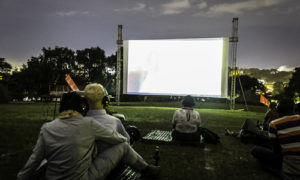 It is a perfect occasion to watch Ugandans showcase their different cultural heritage through amazing performances, fashion shows, music and art. The Amakula International Film Festival on the other had is hosted by the Uganda Museum in collaboration with international and local partners around March every year. It is one of the oldest film festivals in the African continent showing both local and international features. The LaBa! Street Arts Festival brings together some of the best artists in the country in one place to sell their products in open spaces (amidst fanfare and great music performances).
It is a perfect occasion to watch Ugandans showcase their different cultural heritage through amazing performances, fashion shows, music and art. The Amakula International Film Festival on the other had is hosted by the Uganda Museum in collaboration with international and local partners around March every year. It is one of the oldest film festivals in the African continent showing both local and international features. The LaBa! Street Arts Festival brings together some of the best artists in the country in one place to sell their products in open spaces (amidst fanfare and great music performances).
Makerere University: Makerere University is the oldest and largest public university in Uganda. It is one of the best 10 universities in Africa and is Uganda’s main center for research. The University is close to the city center and was built on one of Kampala’s original hills – Makerere hill. 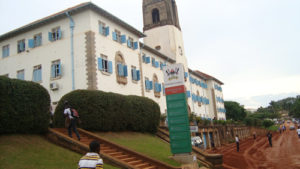 The University begun as a technical school in 1922 and later became part of the new University of East Africa. Under that arrangement, it began offering degrees from the University of London. In 1970, the university became independent after the University of East Africa split into three main universities – Makerere University in Uganda, University of Dares Salaam in Tanzania and the University of Nairobi in Kenya. The university has produced prominent Alumni including presidents like Benjamin Mkapa of Tanzania, Mwai Kibaki of Kenya and the former president of Uganda Milton Obote. You can read more about student trips to Uganda.
The University begun as a technical school in 1922 and later became part of the new University of East Africa. Under that arrangement, it began offering degrees from the University of London. In 1970, the university became independent after the University of East Africa split into three main universities – Makerere University in Uganda, University of Dares Salaam in Tanzania and the University of Nairobi in Kenya. The university has produced prominent Alumni including presidents like Benjamin Mkapa of Tanzania, Mwai Kibaki of Kenya and the former president of Uganda Milton Obote. You can read more about student trips to Uganda.
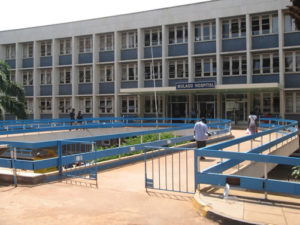 Mulago Hospital: Mulago National hospital is the largest hospital in Uganda. It is built 3.5 kilometers away from the main city center. Mulago hospital started as a treatment center in 1913 before being upgraded to a referral hospital around the 1950’s. Mulago is a major research center producing countless doctors and nurses operating across the globe. The hospital is a great place to visit and marvel at the architecture on display.
Mulago Hospital: Mulago National hospital is the largest hospital in Uganda. It is built 3.5 kilometers away from the main city center. Mulago hospital started as a treatment center in 1913 before being upgraded to a referral hospital around the 1950’s. Mulago is a major research center producing countless doctors and nurses operating across the globe. The hospital is a great place to visit and marvel at the architecture on display.
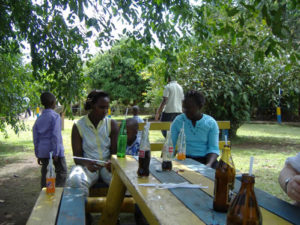 Kiwatule Recreation Centre: The Kiwatule Recreation Centre is one of the best places to go for an outing with family if you live near the Ntinda, Kiwatule, Banda and Kireka areas. The Centre has an amusement park for kids including train rides and a large swimming pool. Adults can sit back and relax as they watch their kids swim, play and run around the facility. There is also an exclusive health and adult club. The Kiwatule Recreation Centre is popular for holding large wedding and parties.
Kiwatule Recreation Centre: The Kiwatule Recreation Centre is one of the best places to go for an outing with family if you live near the Ntinda, Kiwatule, Banda and Kireka areas. The Centre has an amusement park for kids including train rides and a large swimming pool. Adults can sit back and relax as they watch their kids swim, play and run around the facility. There is also an exclusive health and adult club. The Kiwatule Recreation Centre is popular for holding large wedding and parties.
Lugogo Show Grounds: The Lugogo Show Grounds are located away from the city centre. It belongs to the Uganda Manufacturer’s Association and hosts international/national trade shows and exhibitions.
Historical Sites: We have already discussed some of the historical sites in Kampala but one that needs to be mentioned at this point is the cemetery for commonwealth veterans in Nakawa. This is very close to the Lugogo Show grounds and the trading center in Bugolobi. It is the burial ground for many of the soldiers who died during the colonial period and World Wars. The grounds are well kept. Each tomb is decorated with marble gravestones bearing the names of each of the soldier. The cemetery appears quiet on a normal day but receives several visitors each month.
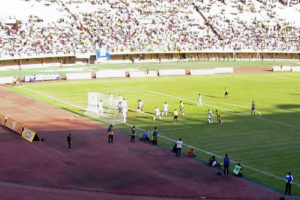 Sports Grounds: The Mandela National Stadium (known locally as Namboole stadium) is the largest sporting ground in Uganda. This is the place to go if one wants to watch the top local teams like KCC, SC Villa, Express and URA in action. Apart from sports, the stadium hosts large political gatherings and Christian crusades. Other important sports grounds include the Lugogo indoor stadium for cricket and tennis. The Lugogo Rugby Club is a favorite hangout for the youth who come to watch their favorite Rugby teams tussle it out among themselves. Please also check out an article about the things to do in Kinshasa. Thank you for reading.
Sports Grounds: The Mandela National Stadium (known locally as Namboole stadium) is the largest sporting ground in Uganda. This is the place to go if one wants to watch the top local teams like KCC, SC Villa, Express and URA in action. Apart from sports, the stadium hosts large political gatherings and Christian crusades. Other important sports grounds include the Lugogo indoor stadium for cricket and tennis. The Lugogo Rugby Club is a favorite hangout for the youth who come to watch their favorite Rugby teams tussle it out among themselves. Please also check out an article about the things to do in Kinshasa. Thank you for reading.


Very detailed information that an individual requires. Well done.
Thanks Andrew. I hope you visit all the amazing places while in Kampala